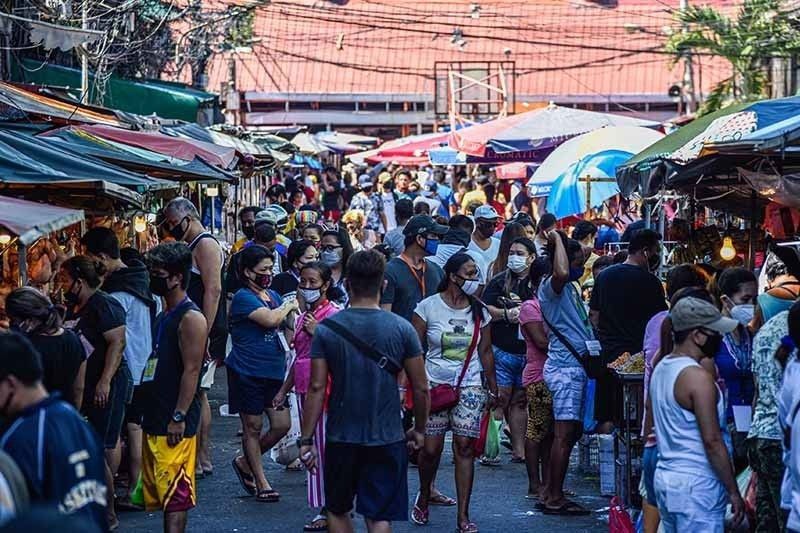Surge in COVID-19 cases seen from overcrowding

MANILA, Philippines — With more people out of their homes during the holiday season, overcrowding in public places may lead to an uptick in COVID-19 cases, an expert from the OCTA Research Group warned yesterday.
In an interview with Teleradyo, University of the Philippines (UP) professor Guido David reminded Filipinos to continue following health protocols to minimize transmission of COVID-19 amid the holiday rush.
The research expert said more Filipinos may be inclined to go out as the economy further reopens, citing pandemic fatigue due to the months of being locked down in their homes.
“We are closely monitoring overcrowding, especially if we allow minors (to go out),” he said in Filipino. “One of the high risks is overcrowding in malls and restaurants.”
David noted the need to limit the movement of minors, citing a study showing that they have a high potential in spreading the virus.
Metro Manila mayors last week decided to retain the ban on minors in malls, citing experts who warned of its impact on the spread of the virus.
The OCTA Research Group, composed of academic experts from UP and the University of Santo Tomas, projected that the number of cases in the country may reach between 470,000 and 500,000 by the end of the month.
In an earlier interview with “The Chiefs” aired on One News/TV 5, David said reaching the 500,000 mark would mean that the “curve is already unflattening and we’re starting on an upward trend” anew.
In its latest report released last week, the OCTA Research Group appealed to the public to avoid not just crowded and enclosed areas but also to refrain from joining or organizing social gatherings this Christmas season.
“There is evidence from Europe and North America that increased social mixing among households is driving the second wave of COVID-19 in these parts of the world,” it said.
It urged the government to enforce the limit on gathering to 10 persons in areas under general community quarantine (GCQ) such as Metro Manila, as well as discourage office parties and other social events.
“Family gatherings should be limited in size and should be celebrated outside to mitigate transmission,” it said.
“Moving forward, we believe that what citizens do will be more important than any intervention the government does in the fight against COVID-19. Hence, we appeal to our citizens to continue to do their share by being vigilant and disciplined in following the minimum health standards,” added the research group.
Meanwhile, the Department of the Interior and Local Government (DILG) urged the public to continue the strict observance of health protocols to prevent a second surge in COVID-19 transmission during the holidays.
Undersecretary Jonathan Malaya, DILG spokesman, said that all individuals should cooperate to sustain the slowdown in COVID-19 transmissions during the Christmas and New Year break.
He said the government is already preparing in case of a spike in COVID-19 cases, including ramping up healthcare and testing capacity and the deployment of more contact tracers.
“We are prepared for it. However, to ensure the prevention of a second wave or surge (of infections), everyone must cooperate,” he said in Filipino in an interview on CNN Philippines.
Health Secretary Francisco Duque III aired the same call as he vowed preparedness on the part of the Department of Health (DOH).
“We are unequivocally prepared for any circumstances that this Yuletide season may bring. We have also increased our COVID-19 bed capacity in different regions with high-risk classifications to prevent saturation in our hospitals,” Duque said.
Malaya said the government is slowly reopening up more industries to jumpstart the economy, which saw a recession due to the COVID-19 pandemic.
“We are as ready as we can be, we have been preparing for a long time. This last quarter is to slowly reopen the economy,” he said, adding that restrictions cannot be prolonged or economic hardships will grip the whole nation.
President Duterte announced that the GCQ status shall be maintained in the National Capital Region or Metro Manila, Davao City and six other areas until the end of the year.
The DOH assured the public that the country’s health system continues to strengthen its capability to respond to the pandemic, with Duque placing the number of beds and equipment for COVID-19 patients at 22,242.
“We are continuously strengthening our health system as part of our COVID-19 response. We want to make sure that we can provide the medical needs of the public given the health crisis that we face,” he said.
DOH data showed that as of Dec. 3, the critical care utilization rate of the country is at 36 percent and this is considered low risk. This pertains to the use of ICU beds, isolation beds and ward beds and mechanical ventilators.
At a 50 percent occupancy rate of COVID-19 beds and equipment, the DOH raises a warning zone; at 70 percent, it is a danger zone.
The DOH has allocated an additional 235 COVID-19 beds for Cagayan Valley, Calabarzon, Davao region and NCR as these areas have the highest number of cases in the country at present. – Romina Cabrera, Sheila Crisostomo
- Latest
- Trending


























